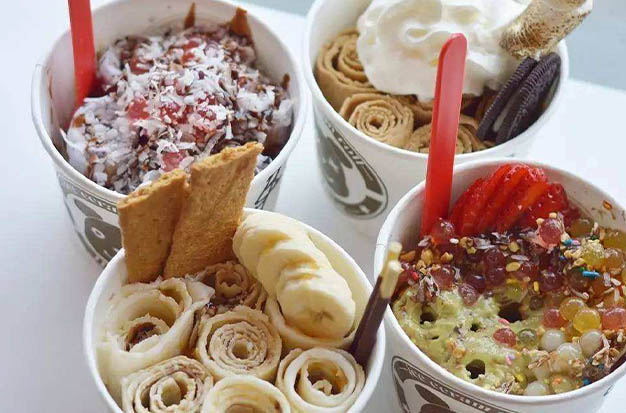Rolled ice cream, also referred to as stir-fried ice cream, is a fantastic frozen treat that is now hugely well-liked all over the world. Who wouldn’t want more information? Learn everything you ever wanted to know about Bubba ice cream rolls’ production in the following paragraphs.
What Does Rolled Ice Cream Mean?
The ultimate food item is rolled ice cream. Seriously, it’s a frozen dessert that combines cream, milk, sugar, and pretty much any flavor you can imagine, making it unbelievably delicious. The mixture is rolled into lovely spirals and stacked vertically in a cup for serving after being flash-frozen on a unique metal pan. Although not required, we highly recommend adding extra toppings. Who wants fresh fruit, crushed cookies, or caramel sauce?
Where Did Rolled Ice Cream Originate?
Rolled ice cream originated in Southeast Asia, with Thailand often getting the credit for inventing the sensational sweet treat (that’s where we discovered it!). Additionally widespread around the world, it is also prevalent in Malaysia and the Philippines. One of the first businesses to introduce the cutting-edge ice cream trend here in the UK was Pan-n-Ice.
Rolled Ice Cream VS. Traditional Ice Cream
The main ways that rolled ice cream differs from traditional ice cream are in the way it is made and served. It is made to order and typically takes between 3-5 minutes to prepare each serving, as opposed to traditional ice cream, which is pre-made and ready to scoop.
Preparation
The base of an ice cream roll is a creamy liquid custard that has been chopped, blended, and combined with additional flavors and ingredients until they are thoroughly and evenly distributed. This liquid mixture is applied to a frozen metal pan and allowed to solidify. (The terms “ice pan ice cream” and “stir-fried ice cream” came from the use of the frozen pan and the stirring motion used to combine the ingredients on it.) With the help of a metal spatula, it is flattened out and scraped into rolls, which are typically arranged vertically in a cup with a variety of toppings.
While it may take longer than just scooping ice cream to serve each customer, this can also allow for more customization. The flavors are better incorporated into the ice cream rolls because many of the ingredients are combined with the cream while it is still in a liquid state. Additionally, because the solidified cream is completely flattened on an ice pan before being rolled up and displayed in an attractive “bouquet,” the texture is a little denser as a result.
Rolled ice cream is actually quite similar to traditional ice cream, aside from the act of preparation and presentation style, since it comes in many of the same flavors with comparable mix-ins, toppings, and variations.
Flavors
As with regular ice cream, ice cream rolls are available in a huge range of flavors. The following flavors rank among the most popular:
- matcha green tea
- cookies ‘n creme
- strawberry
- chocolate
- pistachio
- mango
- vanilla
- coffee
- ube
Mix-ins & Toppings
Along with choosing a base flavor, customers can customize the ice cream’s flavor and texture to their preferences by selecting from a wide variety of mix-ins and toppings offered at numerous ice cream parlors.
- fresh fruits: bananas, strawberries, raspberries, blueberries, blackberries, mangoes, lychee, etc.
- crushed/sliced nuts: almonds, cashews, hazelnuts, macadamia nuts, pistachios, pecans, peanuts, walnuts, Brazil nuts, etc.
- candies: chocolate chips, gummy bears, gummy worms, M&Ms, Reese’s, Andes, Nerds, Skittles, etc.
- chopped candy bars: Granola bars, Heath bars, Kit-Kats, Snickers, Butterfingers, Milky Way, and Hershey’s are a few examples.
- cereals: Fruity Pebbles, Cocoa Pebbles, Lucky Charms, and Froot Loops, among other cereals.
- chewy treats: boba, popping boba, marshmallows, mochi, tapioca, etc.
- cookies/baked goods: Brownie bites, Pirouettes, Oreos, chocolate chip cookie dough, etc.
- crackers: graham crackers, animal crackers, etc.
- sauces: hot fudge, strawberry, caramel, white chocolate, etc.
- sprinkles: edible rainbow sprinkles, chocolate sprinkles, glitter sprinkles, gold sprinkles, etc.

How Is Rolled Ice Cream Made?
The majority of us in the UK are accustomed to eating traditional ice cream in scoops straight out of a tub after it has been prepared in advance and frozen. Certainly tasty, but if we’re being completely honest, a little dull. Ice cream rolls are much more exciting than that because they are made from scratch, by hand, in front of your admiring eyes.
Flat metal pans that are extremely cold—by extremely cold, we mean -30 degrees Celsius (so really, really, ridiculously cold)—are used to make ice cream rolls. These are then covered with the ice cream base and any additional ingredients you choose, such as strawberries and meringue or chocolate and cookies. The mixture is then cut into small pieces with metal spatulas to combine the flavors and incorporate air for a lighter texture. Finally, the flavor-packed mixture is rolled up into spirals after being flattened into a rectangle and divided into strips. Ice cream rolls that are lovely!
How Can Rolled Ice Cream Be Made At Home?
I had to try making this Rolled Ice Cream for myself after seeing it being made. I knew it would take some experimenting because this is not typically something you would make at home. But after only a few tries, I had a strategy, and I was able to create these flawless frozen sweet ice cream rolls at home. It turns out to be much easier than you might think. I simply began with my tried-and-true No Machine Ice Cream recipe, which calls for sweetened condensed milk and cream. That’s right, there are only 2 ingredients in the base of this Rolled Ice Cream, and what’s even better is that they are combined right on the baking sheet they are freezing in. I got creative and added some of my favorite flavorings after mixing everything together on my cold tray.
Ingredients
- 1-pint heavy cream
- 14-ounce can sweetened condensed milk
- Pinch of salt
- Optional mix-ins: Chopped nuts, Oreos, cocoa powder, strawberry jam, sprinkles, caramel, cookie dough
- Optional toppings: Gummy bears, mochi, fresh fruit, sprinkles, cake chunks, chocolate chips, pretzels
Instructions
- Salt, sweetened condensed milk, and heavy cream are combined in a bowl.
- A metal sheet pan or rimmed baking sheet should receive your ice cream base. Make sure it’s 1/8 inch or less thick—less than ¼ inch is preferable. It ought to barely reach the pan’s rim.
- If you want to include a mix-in, sprinkle it on the sheet pan and carefully stir it into the ice cream base with a silicone spatula.
- Place the sheet pan in the freezer for at least 4 hours, or until completely frozen.
- Take the sheet pan out of the freezer when the ice cream is completely solid. Place the sheet pan with the longer side facing you. Slice the ice cream into strips that are 3 inches wide using a paint scraper or flat, sharp-edged metal spatula. As you quickly work your way down from top to bottom, use your spatula to scrape up each strip and then gently push it (at a 45° angle) into a tube shape. Use a butter knife to roll the sheet into a tube shape if the roll needs assistance forming at the pan’s base. The best serving vessels are chilled bowls with straight sides or ramekins. Use tongs to transfer the finished roll to your chosen serving dish. Repeat with the remaining ice cream that is frozen on the sheet pan.
- Add any desired garnishes to complete.
In A Rolled Ice Cream, Which Milk Is Used?
An ice cream roll base works fantastically with both condensed milk and double cream. The base mixture must taste rich, creamy, and delectable and be both freezable and pliable (to allow it to be rolled up properly). Coconut milk works well if you’re looking for a vegan option because it contains a good amount of fat, which will help to give a wonderful texture and flavor.
We’ve perfected the exact quantities of our Pan-n-Ice signature bases over the years, so keep it a secret! – but we can tell you that we offer either a dairy cream base or a vegan coconut milk base mix.
Is Rolled Ice Cream Gluten-free?
Ice cream rolls can be gluten-free, but it depends on the base mixture and ingredients used; obvious ingredients to check include things like biscuits, which are typically made with wheat.
It’s important to keep in mind that since the same pan is frequently used for a variety of orders, there is a chance that ingredients with gluten could contaminate food made with other flavors. Ask the ice cream shop staff for advice if you have a severe allergy; they should be happy to help you.
Conclusion
Everyone is still following this trend that is still popular on social media: An ice cream base, which is essentially a cooked custard, is poured out on a cold stone to create rolled ice cream. This fascinating display of dairy art is named for the ice cream company that used cold stones to mash up its ice cream before adding toppings. The specific kind of cold stone used to make rolled ice cream is called an ice pan, and it maintains a constant temperature of -20 degrees while freezing the base almost instantly.
Although it’s not all that novel in some parts of the world, the process is entertaining to watch and it’s exciting to try ice cream that is being made in such a novel and distinctive way. Prior to spreading throughout the world, the rolled ice cream craze had its origins in South Asia and was known as Thai stir-fry ice cream. The instantaneous freezing of the ice cream makes it velvety smooth, allowing for rolling to create the ice cream tubes that are then topped with your preferred ingredients. This rolling of the ice cream is also not just for show.


